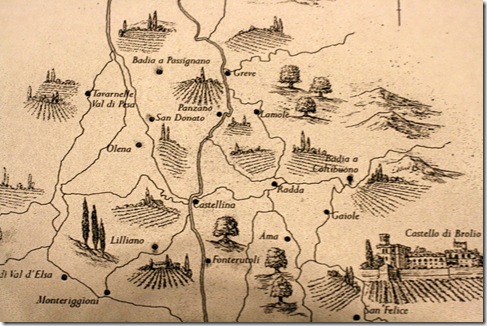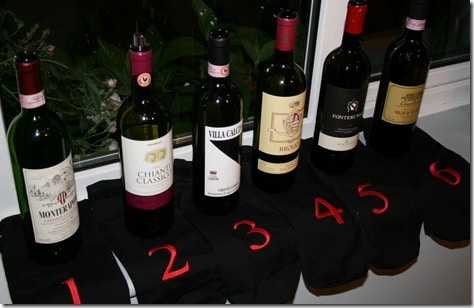The thirty miles between Florence and Siena takes you through one of the most famous landscapes in the world of wine. But while the landscape has enduring appeal – gently undulating hills, now smart renovated farms, vineyards, cypresses, woodlands, more vineyards, medieval towns and castles – the wine is little understood.
This is because the second half of the last century saw this famous name go down all sorts of blind alleys. It is undoubtedly a historic wine but one that has only recently begun to settled down with a clear identity. The debate has focused on:
- the zone: the classic area was given its first designation by Cosima III de’ Medici back in 1716 but in the 1930s the name of Chianti was bestowed on a vast area of central Tuscany between Pisa and Arezzo and well south of Siena. It was not until 1996 that the Classico zone was redefined as the historic area between the two historic Tuscan cities. But how many consumers know the difference between Chianti Classico and Chianti?
- mass market or quality wine? The 1970s and 80s saw subsidised expansion of land under vine at the lowest cost and with no regard for quality and the result. The result was a lot of
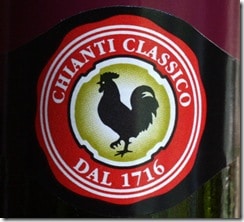 mediocre wine. By contrast, the Chianti 2000 project undertook research into clones of Sangiovese and has enabled Chianti Classico to head in the quality direction. It was spurred on of course by the fame and fortune that was being made by those creating the Super Tuscans, wines made from French grape varieties especially on the Tuscan coast.
mediocre wine. By contrast, the Chianti 2000 project undertook research into clones of Sangiovese and has enabled Chianti Classico to head in the quality direction. It was spurred on of course by the fame and fortune that was being made by those creating the Super Tuscans, wines made from French grape varieties especially on the Tuscan coast. - the blend: at least since the later nineteenth century this has been Sangiovese plus secondary additions of other grapes to soften the wine. Up to 20% of the other local grape varieties (usually Canaiolo, Malvasia Nera, Colorino) gives you one result; 20% of Merlot, Cabernet or Syrah a completely different one. So should Classico be a defined Tuscan style or an international red with a Tuscan twist?
- oak ageing: should the wines be aged in small French barriques, older or newer, or in traditional, larger Slavonian oak barrels? Or in other words, should the fruit have a suave aroma of vanilla and tobacco or the more neutral if perceptible notes of balsamic, cloves and leather?
These questions were given a pretty clear answer in a blind tasting of Chianti Classico wines from the very good 2006 vintage, mostly sourced from the Wine Society. The selection may of course simply reflect the preferences of their buyers but it showed that Classico does now have a clear identity:
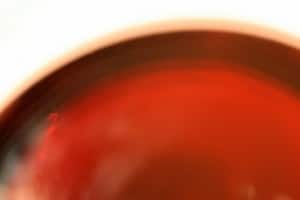 pale to mid ruby red
pale to mid ruby red- distinctive aromas of sour cherry, fresh and dried fruit plus a moderate veneer of oak ageing
- an absolute maximum of 10% of non-Tuscan grapes. More than that and the wines may be good but they won’t be Chianti Classico in style, whatever it says on the label
- good fruit on the palate (but certainly not fruit led) with moderate to high acidity and tannins. The wine at this quality level is no longer either thin or tough as it was in the past, but it is no pushover either – it is quite rightly a wine of medium intensity, complex, lively and refreshing.
- an excellent wine to accompany food including fatty/salty food such as prosciutto or tomato based sauces; good persistence.
Chianti Classico seems to have found its proper and distinctive place in a world awash with big, fruit led, wines – and long may it continue in this style.
The wines
Monteraponi 2006, £14
90% Sangiovese, 10% Canaiolo, 12 months 70% in 23hl casks of Allier oak and 30% second passage barriques. Pale ruby, medium intensity aromas, nice pretty palate of cherry leading in the raspberry and strawberry direction, lowish acidity, subtle. Good plus.
Sainsbury’s Taste the Difference Chianti Classico 2006, made by Cecchi from the Villa Cerna estate, £7.50 Sangiovese, Canaiolo and Colorino grapes, but the proportions not declared. Mid ruby, not a fruity nose but spices, eg cloves, good fruit on the palate which faded in intensity quite quickly but then persisted at a lower level, good plus. Worthwhile introduction to the style and held its own with wines up to nearly twice the price
Villa Calcincaia 2006, £11.25
80% Sangiovese, 10% Canaiolo, 10% Merlot, 18 months in Slavonian oak. Initially muted nose which then opened up, quite perfumed, slightly intenser than average of this field, greater acidity, powerful, quite long if not very complex finish. The relatively substantial amount of Merlot does not dominate the wine.
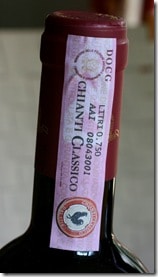 Brolio 2006, £13 The website unhelpfully says: Sangiovese with small addition of other grapes, but probably with some French grapes in the mix because of a deeper colour with a continuing purple tinge. Very good fruit but not a clear Sangiovese profile (?Merlot), good persistence. Very good if heading towards an international style.
Brolio 2006, £13 The website unhelpfully says: Sangiovese with small addition of other grapes, but probably with some French grapes in the mix because of a deeper colour with a continuing purple tinge. Very good fruit but not a clear Sangiovese profile (?Merlot), good persistence. Very good if heading towards an international style.
Fonterutoli 2006, £16. 90% Sangiovese; 5% Malvasia Nera and Colorino; 5% Merlot. Purply red, denser colour; rich, clove nose; velvety dense fruit, more obvious tannins, very good if slightly international in style
Villa di Vetrice, Chianti Rufina Riserva 2006, £8.50: 90% Sangiovese, 10% Canaiolo. Not Classico of course but from the Rufina area directly East of Florence. The most traditional wine in this tasting. Quite a dense ruby, rich and demanding, Sangiovese very dominant, more tannic than acidic, very good plus if very traditional
An older wine for comparison’s sake, with thanks to David Thomas of Caviste: Castello dei Rampolla, Chianti Classico riserva 1998, generally viewed as a decent but not outstanding year in Tuscany. No grape variety breakdown available. Colour very similar to the 2006s, lively pale to mid ruby red, no signs of ageing; complex nose, cloves, some red fruit, leather, fading fruit on the palate but still quite drying tannins. Drink up.
Favourites
The clear favourite of the tasting group was the Monteraponi with its subtle ripe fruit. Then came Brolio. My choice was the traditional wine from Vetrice in Rufina – but that’s just a matter of which style you prefer.

